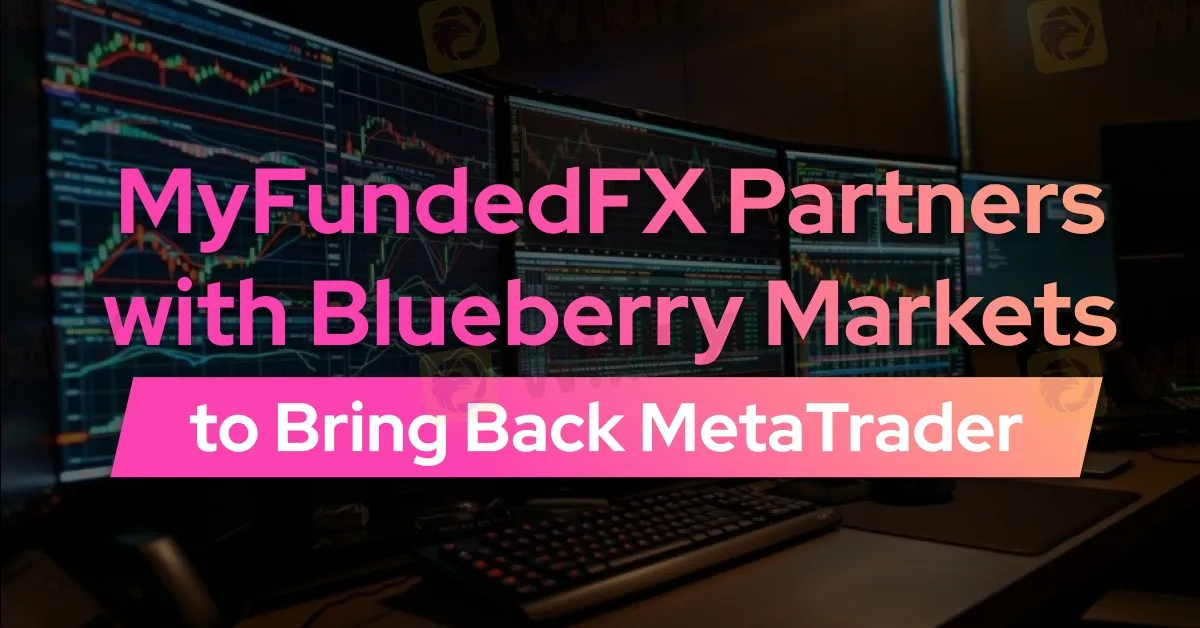简体中文
繁體中文
English
Pусский
日本語
ภาษาไทย
Tiếng Việt
Bahasa Indonesia
Español
हिन्दी
Filippiiniläinen
Français
Deutsch
Português
Türkçe
한국어
العربية
MyFundedFX Partners with Blueberry Markets to Bring Back MetaTrader
Abstract:MyFundedFX, a proprietary trading firm impacted by the reported crackdown on MetaQuotes, has announced a collaboration with Blueberry Markets to offer MetaTrader trading platforms to clients outside the United States.

MyFundedFX, a proprietary trading firm impacted by the reported crackdown on MetaQuotes, has announced a collaboration with Blueberry Markets to offer MetaTrader trading platforms to clients outside the United States.
In a strategic move, the proprietary trading firm has selected Blueberry Markets as its new brokerage partner, replacing ThinkMarkets. ThinkMarkets recently issued notifications instructing existing proprietary trading firms to cease onboarding US registrations and terminate any existing US customers.
After curtailing its services for US customers, MyFundedFX provided an alternative by offering clients the option to migrate to DXtrade, a competing platform to MetaTrader.
On their official Discord server, the broker communicated that MT4 has been reintroduced with Blueberry Markets and is now available for purchase. Non-U.S. customers have the option to switch to Blueberry Markets if they prefer not to transition from ThinkMarkets to DXtrade.

In addition to MetaTrader and DXtrade, the proprietary platform is actively integrating two additional trading platforms: Match-Trade and cTrader.
For US-based clientele, the prop trading platform has already initiated services with DXtrade and will expand offerings to Match-Trade and cTrader. However, MetaTrader will continue to be restricted for US-based traders.
The prop trading firm affirmed its commitment to enhancing services for its U.S. customers by introducing additional platforms and striving for consistency in an industry that has recently lacked it. Currently, the firm offers DXTrade, which includes Tradingview integration, mobile access, and a familiar interface. Additionally, Match Trader and cTrader are being implemented swiftly, with continuous exploration of other opportunities to ensure a comfortable trading environment for U.S. customers.
Concurrently, other proprietary trading platforms without brokerage partners are actively engaging new entities for similar services. MyFlashFunding recently disclosed collaboration with an “ASIC-regulated broker” for its non-U.S. operations, although the broker's identity remains undisclosed. Numerous other proprietary firms have adopted alternatives to MetaTrader, such as DXTrade.

Disclaimer:
The views in this article only represent the author's personal views, and do not constitute investment advice on this platform. This platform does not guarantee the accuracy, completeness and timeliness of the information in the article, and will not be liable for any loss caused by the use of or reliance on the information in the article.
Read more

CySEC Revokes UFX Broker Licence as Reliantco Halts Global Operations
The Cyprus Securities and Exchange Commission (CySEC) has officially withdrawn the Cyprus Investment Firm (CIF) licence of Reliantco Investment Limited, the operator of UFX.com. This decision followed a six-month period during which the company failed to provide any investment services or perform investment activities.

Elon Musk Sparks Debate Over Presidential Power and Federal Reserve Independence
Elon Musk has voiced his support for the controversial idea that United States presidents should have a role in shaping Federal Reserve policies. This endorsement aligns with recent remarks from President-elect Donald Trump, who has hinted at revisiting the central bank's independence, a long-held tradition in the nation's financial governance.

Consob Sounds Alarm: WhatsApp & Telegram Users Vulnerable to Investment Scams
Italy's financial regulator, Consob, has raised alarms over an increase in fraudulent schemes targeting investors through mobile messaging platforms such as WhatsApp and Telegram.

Crypto 101: Coins vs Tokens
For those new to the world of cryptocurrency, terms like "coin" and "token" may seem interchangeable. However, understanding the distinction between these two digital assets is crucial for navigating the crypto landscape. Both coins and tokens serve as integral components of blockchain ecosystems, yet they differ in their functionalities, use cases, and the technologies underpinning them.
WikiFX Broker
Latest News
Tokyo Police Arrest 4 for Unregistered FX Trading Scheme
BSP Shuts Down Uno Forex Over Serious AML Violations
ACY Securities Expands Global Footprint with South Africa Acquisition
Rupee gains against Euro
WikiEXPO Global Expert Interview: The Future of Financial Regulation and Compliance
DFSA Warns of Fake Loan Approval Scam Using Its Logo
Consob Sounds Alarm: WhatsApp & Telegram Users Vulnerable to Investment Scams
CySEC Revokes UFX Broker Licence as Reliantco Halts Global Operations
Bitcoin ETF Options Get Closer to Reality with CFTC Clarification
Peso Depreciation to 59:$1 Likely Amid Strong Dollar Surge
Currency Calculator


